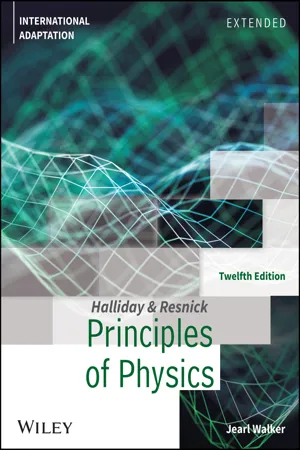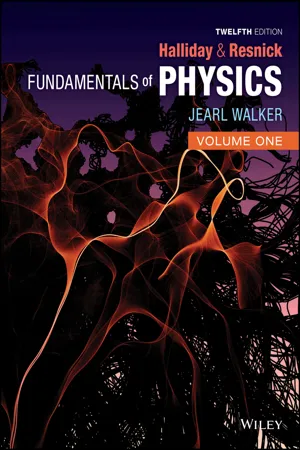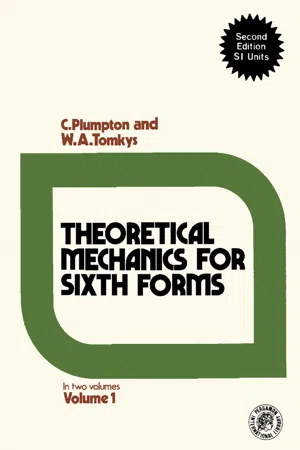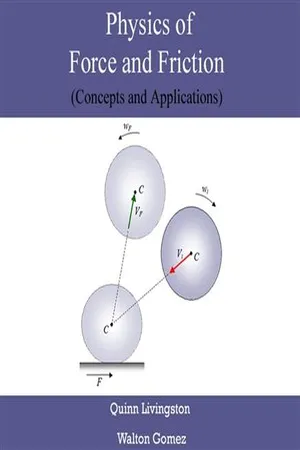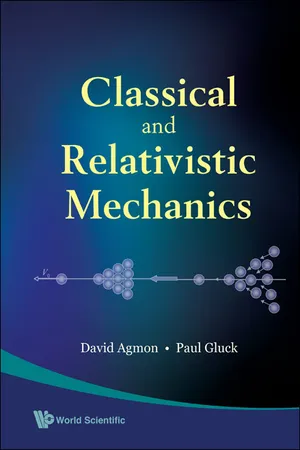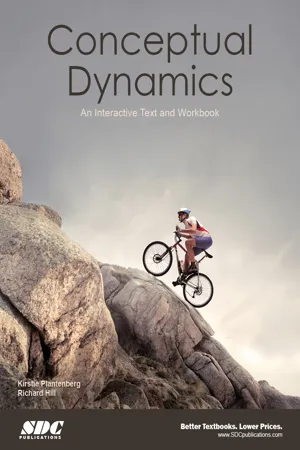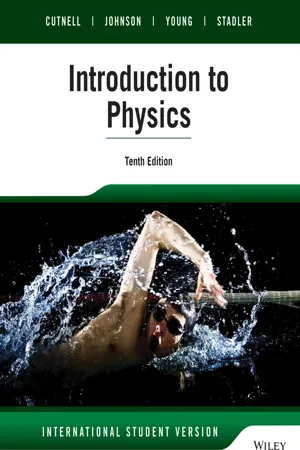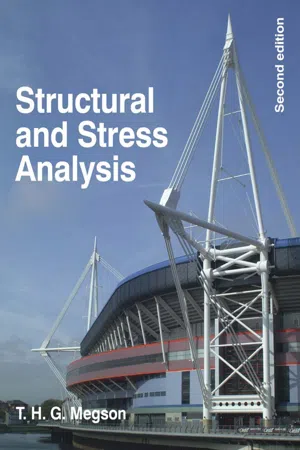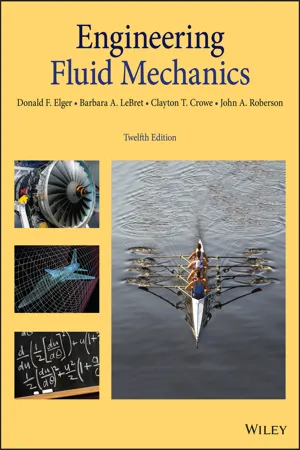Physics
Moments and Equilibrium
Moments in physics refer to the turning effect of a force around a pivot point. Equilibrium occurs when the sum of all the clockwise moments about a pivot point is equal to the sum of all the anticlockwise moments. This means that the object is not rotating and is in a state of balance.
Written by Perlego with AI-assistance
Related key terms
1 of 5
11 Key excerpts on "Moments and Equilibrium"
- David Halliday, Robert Resnick, Jearl Walker(Authors)
- 2023(Publication Date)
- Wiley(Publisher)
A building, for example, should be stable in spite of the gravitational force and wind forces on it, and a bridge should be stable in spite of the gravitational force pulling it downward and the repeated jolting it receives from cars and trucks. One focus of physics is on what allows an object to be stable in spite of any forces acting on it. In this chapter we examine the two main aspects of stability: the equilibrium of the forces and torques acting on rigid objects and the elasticity of nonrigid objects, a property that governs how such objects can deform. When this physics is done correctly, it is the subject of countless articles in physics and engineering journals; when it is done incorrectly, it is the subject of countless articles in newspapers and legal journals. Equilibrium and Elasticity 326 CHAPTER 12 Equilibrium and Elasticity Equilibrium Consider these objects: (1) a book resting on a table, (2) a hockey puck sliding with constant velocity across a frictionless surface, (3) the rotating blades of a ceiling fan, and (4) the wheel of a bicycle that is traveling along a straight path at constant speed. For each of these four objects, 1. The linear momentum P → of its center of mass is constant. 2. Its angular momentum L → about its center of mass, or about any other point, is also constant. We say that such objects are in equilibrium. The two requirements for equilibrium are then P → = a constant and L → = a constant. (12.1.1) Our concern in this chapter is with situations in which the constants in Eq. 12.1.1 are zero; that is, we are concerned largely with objects that are not moving in any way—either in translation or in rotation—in the reference frame from which we observe them. Such objects are in static equilibrium. Of the four objects mentioned near the beginning of this module, only one—the book resting on the table—is in static equilibrium.- eBook - PDF
- David Halliday, Robert Resnick, Jearl Walker(Authors)
- 2021(Publication Date)
- Wiley(Publisher)
A building, for example, should be stable in spite of the gravitational force and wind forces on it, and a bridge should be stable in spite of the gravitational force pulling it downward and the repeated jolting it receives from cars and trucks. One focus of physics is on what allows an object to be stable in spite of any forces acting on it. In this chapter we examine the two main aspects of stability: the equilibrium of the forces and torques acting on rigid objects and the elasticity of nonrigid objects, a property that governs how such objects can deform. When this physics is done correctly, it is the subject of countless articles in physics and engineering journals; when it is done incorrectly, it is the subject of countless articles in newspapers and legal journals. Equilibrium Consider these objects: (1) a book resting on a table, (2) a hockey puck sliding with constant velocity across a frictionless surface, (3) the rotating blades of a ceiling fan, and (4) the wheel of a bicycle that is traveling along a straight path at constant speed. For each of these four objects, C H A P T E R 1 2 345 12.1 EQUILIBRIUM 1. The linear momentum P → of its center of mass is constant. 2. Its angular momentum L → about its center of mass, or about any other point, is also constant. We say that such objects are in equilibrium. The two requirements for equilibrium are then P → = a constant and L → = a constant. (12.1.1) Our concern in this chapter is with situations in which the constants in Eq. 12.1.1 are zero; that is, we are concerned largely with objects that are not moving in any way—either in translation or in rotation—in the reference frame from which we observe them. Such objects are in static equilibrium. Of the four objects mentioned near the beginning of this module, only one—the book resting on the table—is in static equilibrium. The balancing rock of Fig. 12.1.1 is another example of an object that, for the present at least, is in static equilibrium. - eBook - PDF
Theoretical Mechanics for Sixth Forms
In Two Volumes
- C. Plumpton, W. A. Tomkys(Authors)
- 2016(Publication Date)
- Pergamon(Publisher)
If, however, the mass of weight W were moved nearer to G, equilibrium would be broken by the rod turning in a clock-wise direction about G. This tendency of a force to turn a rigid body about an axis is called the turning effect of the force. Experiment shows that, when the rod in this example is in equilibrium, Wxdx = W 2 d 2 . The product Wd is defined as the moment of the force W about G and it is the measure of the turning effect of W± about G. Thus, the Moment of a Force about a point is the product of the force and the perpendicular distance of the point from the line of action of the force. The moment of a force about a line (i.e. about an axis) is defined as the product of the resolved part of the force at right angles to the given line and the shortest distance between the line of action of the force and the given line. In this book we consider systems of coplanar forces only, so that a reference to moment about a point is equivalent to a reference to moment about an axis through that point perpendicular to the plane of the forces. The moment of a force about a point is a directed quantity which can either be counterclockwise (positive in this book) or clock-wise (negative in this book). If a rigid body is in equilibrium under the action of a number of coplanar parallel forces, the sum of the moments of the forces about any point in their plane is zero. This is the Law of the Lever. 132 THEORETICAL MECHANICS Units Since the moment of a force about a point is the product of force and distance, the unit of Moment is the new ton-metre (Nm). This unit is dimensionally equivalent to the unit of work (see Chapter VITI); it is called the joule (J). In § 6.2 the relation between the Law of the Lever and the Parallelo-gram of Forces is considered. Example 1. A thin uniform rod AB of length 2 m and mass 10 kg is supported horizontally at its centre of gravity G and masses of 5 kg, 8 kg are attached to the rod at P, Q respectively, where AP = 0-6 m, AQ = 1-3 m. - No longer available |Learn more
- (Author)
- 2014(Publication Date)
- Academic Studio(Publisher)
When the pressing force is removed the spring attains its original state. 2. Statics Example of a beam in static equilibrium. The sum of force and moment is zero. Statics is the branch of mechanics concerned with the analysis of loads (force, torque/moment) on physical systems in static equilibrium, that is, in a state where the relative positions of subsystems do not vary over time, or where components and structures are at a constant velocity. When in static equilibrium, the system is either at rest, or its center of mass moves at constant velocity. The study of moving bodies is known as dynamics, and in fact the entire field of statics is a special case of dynamics. ________________________ WORLD TECHNOLOGIES ________________________ By Newton's first law, this situation implies that the net force and net torque (also known as moment of force) on every body in the system is zero. From this constraint, such quantities as stress or pressure can be derived. The net forces equalling zero is known as the first condition for equilibrium, and the net torque equalling zero is known as the second condition for equilibrium. Solids Statics is used in the analysis of structures, for instance in architectural and structural engineering. Strength of materials is a related field of mechanics that relies heavily on the application of static equilibrium. A key concept is the center of gravity of a body at rest: it represents an imaginary point at which all the mass of a body resides. The position of the point relative to the foundations on which a body lies determines its stability towards small movements. If the center of gravity exists outside the foundations, then the body is unstable because there is a torque acting: any small disturbance will cause the body to fall or topple. If the center of gravity exists within the foundations, the body is stable since no net torque acts on the body. - eBook - PDF
- David Agmon, Paul Gluck;;;(Authors)
- 2009(Publication Date)
- WSPC(Publisher)
Chapter 4 Statics 93 This equation is equivalent to three component equations 5X=°. !*,=«. 2X=° We show two examples for the vanishing vector sum of four forces acting on a particle in a plane. In this chapter, all the problems will be restricted to the xy plane. (b) Extended objects. An extended object has three additional degrees of freedom pertaining to possible rotations about three axes, so that a condition additional to (4.1) must be stipulated to ensure equilibrium, both translational and rotational. This is -o-clear from the diagram which shows two equal and opposite forces acting on the slab, yet the body will rotate and will not be in equilibrium. Rotation is caused by moments of forces, or torques, denoted by T, and the additional condition for equilibrium is formulated in terms of them: the vector sum of the external torques acting on a body must vanish, 5> = 0 (4.2) We now turn to the definition of moments, with the help of the adjoining diagram. Let P denote the point of application of force F, let the axis of rotation perpendicular to the page pass through point A and let R be the vector from A to P. The angle 0 is that formed between R and F when they are translated so that their tails touch, as shown. The moment of F about the point A, denoted by r A , is defined by the vector product of R with F T A ^RxF (4.3) Its magnitude is |r A | = |fl||F|-sin0 (4.4) The direction of r A is determined, as usual for a vector product, by the right-hand rule. It is into the page in the present case. Comments: 1. The same force will have different moments about different points, yet the condition for equilibrium (4.3) holds when moments are taken about any (convenient) point whatsoever, be it within or outside the body, about a real or virtual axis of rotation. This is easily proved by referring to the figure, in which points A and B are the two points about which we take moments, and R AB is the vector joining them. - eBook - PDF
- Richard C. Hill, Kirstie Plantenberg(Authors)
- 2013(Publication Date)
- SDC Publications(Publisher)
Do you think this fact changes this equilibrium equation? Consider the car shown in Figure 6.5 - 2. Imagine you are driving the car down a road with constant velocity. Under this situation, all of the moments are balanced. But what happens when you suddenly slam on the brakes? The car tips forward*. Why does it tip forward if it was initially going in a straight line and the deceleration the mass center experiences is in that same line? It is because the moments are no longer in balance. As a result, the moments applied to a body that is both accelerating and undergoing pure translation will not balance (M ≠ 0), unless the moments are taken about the body's center of mass (G). A useful way to analyze a body that is translating and accelerating is to apply d'Alembert's principle. D'Alembert's principle states that the product of the mass m of a body with its acceleration is equal in every respect to the resultant of all forces acting on m. We have already seen, through Newton's second law, that the sum of all forces acting on a body (F) is equal to its mass multiplied by its acceleration (ma). The product of the mass of a body with its acceleration (ma) is called the effective force. In other words, the effective force (ma) is in equilibrium with the sum of all forces acting on the body (F). The word equilibrium may be a strange way to describe forces acting on an accelerating body, but the effective force allows us to look at a dynamic body in a different way. If we apply the reverse effective force (-ma) to the body's center of mass, it transforms the system to static *Note A real car, while decelerating, pitches forward because it is not rigid. There is compliance in its suspension and tires. Conceptual Dynamics Kinetics: Chapter 6 – Rigid Body Newtonian Mechanics 6 - 19 equilibrium as shown in the equation below. Figure 6.5-3 shows the free-body diagram of a car with the reverse effective force applied at the center of mass. - eBook - PDF
- John D. Cutnell, Kenneth W. Johnson, David Young, Shane Stadler(Authors)
- 2015(Publication Date)
- Wiley(Publisher)
The large counterweight on the right side (short end) of this tall tower crane ensures its boom remains balanced on its mast while lifting heavy loads. It is not equal weights on both sides of the tower that keep it in equilibrium, but equal torques. Torque is the rotational analog of force, and is an important topic of this chapter. 9 | Rotational Dynamics Chapter | 9 LEARNING OBJECTIVES After reading this module, you should be able to... 9.1 | Distinguish between torque and force. 9.2 | Analyze rigid objects in equilibrium. 9.3 | Determine the center of gravity of rigid objects. 9.4 | Analyze rotational dynamics using moments of inertia. 9.5 | Apply the relation between rotational work and energy. 9.6 | Solve problems using the conservation of angular momentum. 9.1 | The Action of Forces and Torques on Rigid Objects The mass of most rigid objects, such as a propeller or a wheel, is spread out and not con- centrated at a single point. These objects can move in a number of ways. Figure 9.1a il- lustrates one possibility called translational motion, in which all points on the body travel on parallel paths (not necessarily straight lines). In pure translation there is no rotation of any line in the body. Because translational motion can occur along a curved line, it is often called curvilinear motion or linear motion. Another possibility is rotational motion, which may occur in combination with translational motion, as is the case for the somersaulting gymnast in Figure 9.1b. We have seen many examples of how a net force affects linear motion by causing an object to accelerate. We now need to take into account the possibility that a rigid object can also have an angular acceleration. A net external force causes linear motion to change, but what causes rotational motion to change? For example, something causes the rotational velocity of a speedboat’s propeller to change when the boat accelerates. - eBook - PDF
- John D. Cutnell, Kenneth W. Johnson, David Young, Shane Stadler(Authors)
- 2018(Publication Date)
- Wiley(Publisher)
They can produce a translational acceleration a (components a x and a y ). The forces can also produce torques, which can cause the object to have an angular acceleration . In general, we can deal with the resulting combined motion by using Newton’s second law. For the translational motion, we use the law in the form ΣF = ma. For the rotational motion of a rigid object about a fixed axis, we use the law in the form Σ = I. When a (both components) and are zero, there is no acceleration of any kind, and the object is in equilibrium. This is the situation already discussed in Section 9.2. If any component of a is nonzero or if is nonzero, we have accelerated motion, and the object is not in equilibrium. Examples 10 and 11 deal with this type of situation. Moment of inertia Angular acceleration Thin-walled hollow cylinder or hoop Solid cylinder or disk Thin rod, axis perpendicular to rod and passing through center Thin rod, axis perpendicular to rod and passing through one end Solid sphere, axis through center Solid sphere, axis tangent to surface Thin-walled spherical shell, axis through center Thin rectangular sheet, axis parallel to one edge and passing through center of other edge Thin rectangular sheet, axis along one edge I = MR 2 2 5 – I = MR 2 7 5 – I = MR 2 2 3 – I = ML 2 1 12 –– I = ML 2 1 12 –– I = MR 2 1 2 – I = MR 2 R R R L L L L R I = ML 2 1 3 – I = ML 2 1 3 – R TABLE 9.1 Moments of Inertia I for Various Rigid Objects of Mass M 238 CHAPTER 9 Rotational Dynamics EXAMPLE 9 The Moment of Inertia Depends on Where the Axis Is Two particles each have a mass M and are fixed to the ends of a thin rigid rod, whose mass can be ignored. The length of the rod is L. Find the moment of inertia when this object rotates relative to an axis that is per- pendicular to the rod at (a) one end and (b) the center. (See Interactive Figure 9.17.) Reasoning When the axis of rotation changes, the distance r between the axis and each particle changes. - eBook - PDF
- T.H.G. Megson(Author)
- 2005(Publication Date)
- Butterworth-Heinemann(Publisher)
in statical equilibrium, the resultant force on the particle or body must be zero. It follows that if a body (generally in structural analysis we are concerned with bodies, i.e. structural members, not particles) is not to move in a particular direction, the resultant force in that direction must be zero. Furthermore, the prevention of the movement of a body in two directions at right angles ensures that the body will not move in any direction at all. Then, for such a body to be in equilibrium, the sum of the components of all the forces acting on the body in any two mutually perpendicular directions must be zero. In mathematical terms and choosing, say, the x and y directions as the mutually perpendicular directions, the condition may be written F x = 0 F y = 0 (2.8) However, the condition specified by Eq. (2.8) is not sufficient to guarantee the equi-librium of a body acted on by a system of coplanar forces. For example, in Fig. 2.19 the forces F acting on a plate resting on a horizontal surface satisfy the condition ∑ F x = 0 34 • Chapter 2 / Principles of Statics Plate y F F x a F IGURE 2.19 Couple produced by out-of-line forces (there are no forces in the y direction so that ∑ F y = 0 is automatically satisfied), but form a couple Fa which will cause the plate to rotate in an anticlockwise sense so long as its magnitude is sufficient to overcome the frictional resistance between the plate and the surface. We have also seen that a couple exerts the same moment about any point in its plane so that we may deduce a further condition for the statical equilib-rium of a body acted upon by a system of coplanar forces, namely, that the sum of the moments of all the forces acting on the body about any point in their plane must be zero. Therefore, designating a moment in the xy plane about the z axis as M z , we have M z = 0 (2.9) Combining Eqs (2.8) and (2.9) we obtain the necessary conditions for a system of coplanar forces to be in equilibrium, i.e. - eBook - PDF
- Donald F. Elger, Barbara A. LeBret, Clayton T. Crowe, John A. Roberson(Authors)
- 2019(Publication Date)
- Wiley(Publisher)
156 The Momentum Equation CHAPTER ROAD MAP This chapter presents (a) the linear momentum equation and (b) the angular momentum equation. Both equations are derived from Newton’s second law of motion. CHAPTERSIX FIGURE 6.1 Engineers design systems by using a small set of fundamental equations, such as the momentum equation. (Photo courtesy of NASA.) LEARNING OUTCOMES NEWTON’S SECOND LAW (§6.1) ● Know the main ideas about Newton’s second law of motion. ● Solve problems that involve Newton’s second law by applying the visual solution method. THE LINEAR MOMENTUM EQUATION (§6.2 to §6.4) ● List the steps to derive the momentum equation and explain the physics. ● Draw a force diagram and a momentum diagram. ● Explain or calculate the momentum flow. ● Apply the linear momentum equation to solve problems. MOVING CONTROL VOLUMES (§6.5) ● Distinguish between an inertial and noninertial reference frame. ● Solve problems that involve moving control volumes. 6.1 Understanding Newton’s Second Law of Motion The momentum equation, which is the subject of this chapter, is useful for solving many types of engineering problems. For example, the momentum equation is applied to the design of rockets; see Fig. 6.1. The momentum equation is derived from Newton’s second law of motion, which is described next. Body and Surface Forces A force is an interaction between two bodies that can be idealized as a push or pull of one body on another body. A push/pull interaction is one that can cause acceleration. Newton’s third law tells us that forces must involve the interaction of two bodies and that forces occur in pairs. The two forces are equal in magnitude, opposite in direction, and colinear. EXAMPLE. To give examples of force, consider an airplane that is flying in a straight path at constant speed (Fig. 6.2). Select the airplane as the system for analysis. Idealize the air- plane as a particle. Newton’s first law (i.e., force equilibrium) tells us that the sum of forces must balance. - eBook - PDF
Principles of Continuum Mechanics
Conservation and Balance Laws with Applications
- J. N. Reddy(Author)
- 2017(Publication Date)
- Cambridge University Press(Publisher)
5.3 Balance of Momenta 5.3.1 Principle of Balance of Linear Momentum The principle of balance of linear momentum, or Newton’s second law of motion, applied to a set of particles (or rigid body) can be stated as the time rate of change of (linear) momentum of a collection of particles equals the net force exerted on the collection. Written in vector form, the principle implies d dt ( m v ) = F , (5 . 3 . 1) where m is the total mass, v the velocity, and F the resultant force on the collection of particles. For constant mass, Eq. (5.3.1) becomes F = m d v dt = m a , (5 . 3 . 2) which is the familiar form of Newton’s second law. Newton’s second law for a control volume Ω can be expressed as F = ∂ ∂t Z Ω ρ v dv + Z Γ ρ vv · d s , (5 . 3 . 3) where F is the resultant force and d s denotes the vector representing an area element of the outflow. Several simple examples that illustrate the use of Eq. (5.3.2) or (5.3.3) are presented next. 142 CONSERVATION AND BALANCE LAWS Example 5.3.1 Suppose that a jet of fluid with area of cross section A 0 and mass density ρ issues from a nozzle with a velocity v 0 and impinges against a smooth inclined flat plate, as shown in Fig. 5.4. Assuming that there is no frictional resistance between the jet and plate, determine the distribution of the flow and the force required to keep the plate in position. F ˆ n θ t L A R A 0 v 0 v 0 v 0 A cv cs Fig. 5.4 Jet of fluid impinging on an inclined plate Solution: Since there is no change in pressure or elevation before and after impact, the velocity of the fluid remains the same before and after impact. Let the amounts of flow to the left be Q L and to the right be Q R . Then the total flow Q 0 = v 0 A 0 of the jet is equal to the sum (by continuity equation) Q 0 = Q L + Q R . (1) Next, we use the principle of balance of linear momentum to relate Q L and Q R .
Index pages curate the most relevant extracts from our library of academic textbooks. They’ve been created using an in-house natural language model (NLM), each adding context and meaning to key research topics.
